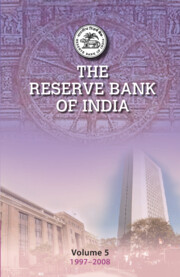Book contents
- Frontmatter
- Contents
- Tables
- Boxes
- Foreword
- Preface
- Acknowledgements
- List of Abbreviations
- 1 Introduction: Managing Liberalisation
- 2 The Macroeconomic Context
- 3 Monetary Management
- 4 Foreign Exchange Market and Management of the Capital Account
- 5 Foreign Exchange Reserves Management
- 6 Financial Markets
- 7 Public Debt Management
- 8 The Payment and Settlement Systems
- 9 Currency Management
- 10 Regulation of the Financial System – Part I: Commercial Banks
- 10 Regulation of the Financial System Part II: Other Financial Institutions
- 11 Supervision of the Financial System
- 12 Rural Credit
- 13 Financial Inclusion
- 14 Communication Policy
- 15 Organisational Change
- Appendices
- Photographs
- Select Bibliography
- Index
9 - Currency Management
Published online by Cambridge University Press: 10 January 2023
- Frontmatter
- Contents
- Tables
- Boxes
- Foreword
- Preface
- Acknowledgements
- List of Abbreviations
- 1 Introduction: Managing Liberalisation
- 2 The Macroeconomic Context
- 3 Monetary Management
- 4 Foreign Exchange Market and Management of the Capital Account
- 5 Foreign Exchange Reserves Management
- 6 Financial Markets
- 7 Public Debt Management
- 8 The Payment and Settlement Systems
- 9 Currency Management
- 10 Regulation of the Financial System – Part I: Commercial Banks
- 10 Regulation of the Financial System Part II: Other Financial Institutions
- 11 Supervision of the Financial System
- 12 Rural Credit
- 13 Financial Inclusion
- 14 Communication Policy
- 15 Organisational Change
- Appendices
- Photographs
- Select Bibliography
- Index
Summary
Introduction
Currency management involves matching the supply of currency (notes and coins) to levels of demand, efforts to achieve self-sufficiency in the production of notes and coins, creating appropriate denomination mix, improvement in distribution networks, withdrawal and destruction of notes, and enhancement in the security features of currency notes. These responsibilities are discharged by the Department of Currency Management (DCM). The function of note issue and currency management is performed through the Reserve Bank’s regional issue offices and sub-offices, and a wide network of currency chests maintained by banks and government treasuries spread across the country. The Bank also coordinates with various agencies such as the note printing presses, mints, railways, police, Indian Airlines (subsequently known as Air India) and the Indian Air Force.
The activities of the Bank in this field encompass both policy matters and institutional measures. The former includes forecasting annual requirements of coins and notes, liaising with the printing presses and mints, and dealing with security issues and counterfeits jointly with other agencies of the government. The latter includes periodic allocation of notes and coins amongst the Bank’s regional offices, extending currency chest facilities to banks, processing and destruction of soiled notes, revision of policy and procedural guidelines on note exchange facility, adjudication of notes and responding to queries received in this regard, and various customer service issues.
Notwithstanding the decline in the share of currency in broad money after the nationalisation of banks (July 1969, see Figure 9.1), cash remained an important mode of payment in the Indian economy. During the reference period, currency in circulation was an important indicator of economic activity, especially in rural India. Cash demand tended to increase at the beginning of the month, when salaries were spent, and tapered off towards the end of themonth. Similarly, currency seasonality, by and large, mirrored events, such as festivals, elections and the seasonality of economic activity.
The importance of cash in the economy made currency management a particularly significant operation as these impacted the economic and social fabric of a vast segment of the population in one form or other. The long-run secular decline in the share of currency in broad money, however, continued.
- Type
- Chapter
- Information
- The Reserve Bank of IndiaVolume 5, 1997–2008, pp. 336 - 372Publisher: Cambridge University PressPrint publication year: 2023



